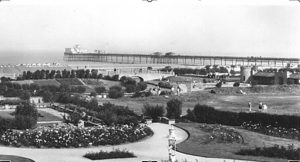SHERWOOD LIFE – DECEMBER, 2022
Shirley Moore, Chairperson for the Edwinstowe Historical Society, welcomed the members to the October meeting, and introduced Bob Massey whose talk was about Skegness. She also asked the members present for their views on having a “fuddle” during the summer months, rather than the lunch in January. It was unanimously agreed that a summer “fuddle” was preferable.
Skegness – a harbour?, smuggling?, steamer trips from the pier?. All true, as Bob Massey explained. Originally Skegness was sited farther east at the mouth of the Wash, where a headland protected the harbour which, in the 14th century, was an important port for coastal trade. Erosion in the Middle Ages and a storm in the 1520’s led to the rebuilding of the new shoreline.
 At first Skegness was a small fishing and farming village, but became an important centre for smuggling goods from Europe during the 18th century. The Vine Hotel in Skegness was the haunt of a famous gang of smugglers. At this time a large portion of land was enclosed, and people began visiting the village because sea air was thought to have health giving-qualities, and bathing machines were available. With the coming of the railway in 1873 the Earl of Scarborough funded development of the town. The Pier opened in 1881, and daily steamer excursions would operate across the Wash to Norfolk. Sadly, devastating storms in 1978 and 1987 damaged the pier and its concert hall, leaving just a shortened length of structure. Additional attractions were Pleasure Gardens, and bathing pools, and a landmark for the town was the Jubilee Clock Tower. Newspapers carried advertisements for properties, and shops began opening. In 1908 the famous “Jolly Fisherman” poster was used by GNR to advertise day trips from King’s Cross in London. The new Skegness became a popular destination for holidaymakers and day trippers from the East Midlands’ factory towns, and although the amenities and attractions have changed with the times, the town continues to be popular with thousands of visitors each year.
At first Skegness was a small fishing and farming village, but became an important centre for smuggling goods from Europe during the 18th century. The Vine Hotel in Skegness was the haunt of a famous gang of smugglers. At this time a large portion of land was enclosed, and people began visiting the village because sea air was thought to have health giving-qualities, and bathing machines were available. With the coming of the railway in 1873 the Earl of Scarborough funded development of the town. The Pier opened in 1881, and daily steamer excursions would operate across the Wash to Norfolk. Sadly, devastating storms in 1978 and 1987 damaged the pier and its concert hall, leaving just a shortened length of structure. Additional attractions were Pleasure Gardens, and bathing pools, and a landmark for the town was the Jubilee Clock Tower. Newspapers carried advertisements for properties, and shops began opening. In 1908 the famous “Jolly Fisherman” poster was used by GNR to advertise day trips from King’s Cross in London. The new Skegness became a popular destination for holidaymakers and day trippers from the East Midlands’ factory towns, and although the amenities and attractions have changed with the times, the town continues to be popular with thousands of visitors each year.
Rather strange to think that when people refer to Skegness as “Skeggy” they could be using the Old Norse word skeggi (meaning “bearded one”) used to describe the shape of the landform.
 Edwinstowe Historical Society
Edwinstowe Historical Society